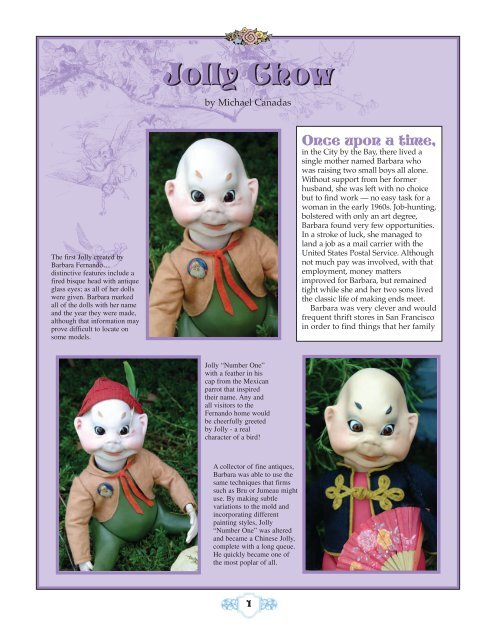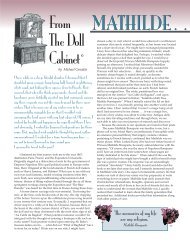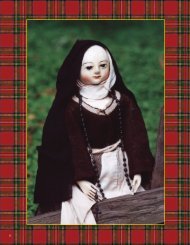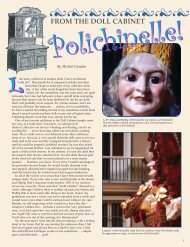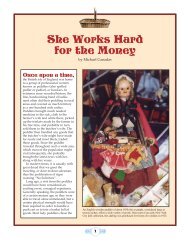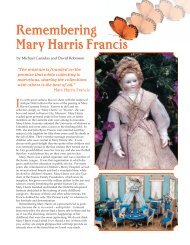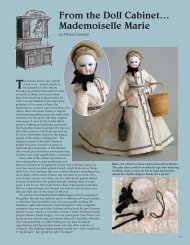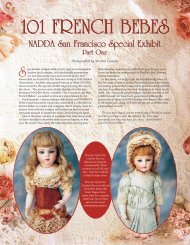by Michael Canadas - Carmel Doll Shop
by Michael Canadas - Carmel Doll Shop
by Michael Canadas - Carmel Doll Shop
- No tags were found...
You also want an ePaper? Increase the reach of your titles
YUMPU automatically turns print PDFs into web optimized ePapers that Google loves.
Jolly Chow<strong>by</strong> <strong>Michael</strong> <strong>Canadas</strong>The first Jolly created <strong>by</strong>Barbara Fernando…distinctive features include afired bisque head with antiqueglass eyes; as all of her dollswere given. Barbara markedall of the dolls with her nameand the year they were made,although that information mayprove difficult to locate onsome models.Once upon a time,in the City <strong>by</strong> the Bay, there lived asingle mother named Barbara whowas raising two small boys all alone.Without support from her formerhusband, she was left with no choicebut to find work — no easy task for awoman in the early 1960s. Job-hunting,bolstered with only an art degree,Barbara found very few opportunities.In a stroke of luck, she managed toland a job as a mail carrier with theUnited States Postal Service. Althoughnot much pay was involved, with thatemployment, money mattersimproved for Barbara, but remainedtight while she and her two sons livedthe classic life of making ends meet.Barbara was very clever and wouldfrequent thrift stores in San Franciscoin order to find things that her familyJolly “Number One”with a feather in hiscap from the Mexicanparrot that inspiredtheir name. Any andall visitors to theFernando home wouldbe cheerfully greeted<strong>by</strong> Jolly - a realcharacter of a bird!A collector of fine antiques,Barbara was able to use thesame techniques that firmssuch as Bru or Jumeau mightuse. By making subtlevariations to the mold andincorporating differentpainting styles, Jolly“Number One” was alteredand became a Chinese Jolly,complete with a long queue.He quickly became one ofthe most poplar of all.1
Long before most Americancollectors had even heard ofBeccassine, Barbara was notonly collecting them, shecreated them in the Jollyline. Beccassine was theonly doll that utilized acommercially made body.Only four examples weremade and only one with asmiling face. Barbara lovedthe idea of Beccassine, butcreating her in doll formwasn’t a real challenge forher talent.Teddy Bears were all the rage during the timeJollies were being made and Barbara made herversion with a bisque head. Few were made asTeddy wasn’t the most enjoyable for her andJim, who sewed the bodies, didn’t find thebrown fur fun to work with. As a result, Teddyis a rare piece in the Jolly family.There are many funny stories about Ba<strong>by</strong>Deena, who was named after a good friend ofthe Fernando’s. Many people believe that all ofthe babies in the Jolly line are Deena, but theonly true Deena features a curl of real hair.Barbara was an expert at working withporcelain lace, even on this tiny sized doll.This simple little Jolly Ba<strong>by</strong>, with its “Hureteyes” originally sold for fifty dollars. Manyindividuals would attempt to buy them up andresell them for a substantial markup, whichBarbara would have none of! Barbara preferredher dolls go to collectors who appreciatedthem, no matter their budgets.2
could use at prices that would fit inher tight budget. In those“modern” years, it was onlynatural that dolls were beingpulled out of the big San Franciscohomes, and some found their wayinto thrift shops. Having loveddolls as a child, Barbara foundherself attracted to those toys of thepast and she bought as many asshe could on her limited means –many for just a few dollars each.Before long, she had assembledquite a collection. Remember, shewas doing this collecting on herown, very early on. There were fewbooks pertaining to dolls availablein the early 1960s and there werevirtually doll no shows. It wouldbe some time before an event suchas a doll show would even exist.Eventually, Barbara discoveredthe Alameda Flea Market across thebay, which quickly became hervehicle to buy and sell. During theweek, she would travel around andbuy dolls or related items withpotential, use her talent to fix themup and resell them the nextweekend. This sideline helpedbring in extra money for her familyand also allowed her to keep somenice pieces for herself. Barbaramaintained that hectic pace whichincluded working for the postoffice, caring for her family, and theselling activities on the weekend,for many years.In time, her efforts were metwith success, when Barbara beganto have doll collectors coming tothe market, just to see what sheoffered for sale. Then, as now, itwas not always easy to find dollsfor resale, so Barbara placed an adin the newspaper — looking to buydolls. Obviously <strong>by</strong> that time, otherpeople in San Francisco were alsocollecting dolls. One collector <strong>by</strong>the name of Jim Fernando readBarbara’s ad and thought tohimself; if someone was looking tobuy dolls, it might figure that theyhad dolls for sale. Jim replied toBarbara’s advertisement and yes,Mold “Number Two”features paint decorationchanged to give the doll adifferent look and thehead was opened at thetop for the queue. Jimsupplied the wigs and theirstyles for the Jollies.In this second creation <strong>by</strong>Barbara, one is able to seeperfected skills in thesculpting of the doll’s head.Different sized antique eyeswere used, lending eachpiece its unique appearance.A pair of “one of akinds”. The Indianwas made frommold “NumberThree”. Barbaramade them asprototypesand…just for fun3
Barbara and Jim Fernandotake a break from work,during the UFDC RegionalConference their doll clubhosted. Both Jim andBarbara gave wholeheartedlyto the hob<strong>by</strong> theyloved and “Easter Fantasy”was a great success.“Jolly Jammy” was one ofBarbara’s last creations andone that she enjoyedcreating the most. With abisque head and arms on acloth body, this doll wasvery popular. Collectorsloved the smiling face andthe cuddly body. Jammyoriginally sold for threehundred dollars at a timewhen most artists wereselling dolls for muchmore. Barbara had to bevery careful with the costsof materials to be able tosell at those prices.Only three of the Jolly Fairies were ever made. The five-piece body wasmade of latex poured in a mold, but to create the bent legs, Barbara sculptedthis leg model <strong>by</strong> hand. The wings incorporate real fairy dust!she did have dolls for sale. Jim scheduledan appointment to meet her and look atthe dolls. Having never met previously,Barbara and Jim soon discovered theyhad many friends in common. The twobecame inseparable. In time, they becamea couple, married, and then went aboutthe business of merging their households,children and doll collections!Jim has always held a deep love forBebe Bru dolls and noticed that Barbaradid not have a single example in hercollection. He just assumed that shedidn’t like them. Barbara instantlycorrected him; of course she liked them— she could never afford to keep them!Working together as a team, Jim andBarbara comprised a perfect couple, forin the late 1970s and early 1980s, thehob<strong>by</strong> of doll collecting was just hittingfull stride. Both brought their uniquetalents to the business of dolls and for thefirst time in many years Barbara didn’tfeel the weight of the world on hershoulders. She enjoyed life throughnumerous trips to Europe to buy forboth their combined collection and forbusiness reasons as well. Barbara alsofound time to return to the art thatshe loved.Some may find it hard to believe, butat some point, even the most perfect dollwill need repair. Through their business,Jim and Barbara were stockpiling quite alot of dolls that needed work, in order tomake them presentable. Many of thetouches the dolls required, Barbarathought beyond her skill, so upon seeingan ad for a course on doll repair, sheimmediately signed up for the class. Shesoon discovered the course was notlimited to doll repair; she would learnhow to make a bisque doll from start tofinish! Barbara learned to sculpt a doll,make a plaster mold and while becomingentirely fascinated with the doll makingprocess — forgot all about the aspect ofdoll repair!Both Barbara and Jim had alwaysloved the Palmer Cox Brownies andtogether, accumulated a fantasticcollection. Just for fun, Barbara decidedto make some dolls inspired <strong>by</strong> theBrownies, but uniquely BarbaraFernando creations.4
Working strictly for her ownpleasure, she sculpted someheads, made the molds and <strong>by</strong>working long hours in thebasement of their San Franciscohome, put together some dolls.The imaginative dolls werecomposed of fantastical bisqueheads on very unusual, longlimbedlatex bodies.One day Barbara received acharming catalog from the mailorder decorating company —Horchow. Sparked <strong>by</strong> aninstantaneous love of all of theirthings, she decided to inquire ifthey would be interested incarrying her new dolls in theirproduct line. In honor of her petparrot and inspired <strong>by</strong> thecatalog, Barbara named her dolls“Jolly Chow”. Was Barbara eversurprised when the HorchowCompany not only loved herunique creations, they orderedsix dozen of each doll and animalstyle! Not expecting that kind ofreaction to her dolls and frankly,rather mystified, Barbara decidedto take some examples to theupcoming UFDC nationalconvention, to see what kind ofresponse the “Jollies” wouldreceive in a doll-friendlyaudience. Jim and Barbara wereknown for carrying fine antiquedolls, so Barbara was a bitsheepish about putting her artistpieces out.At that time in the UFDC salesroom’s history, Chairman RalphGriffith spoke the last word onwhat could or could not beoffered for sale in his room.When Ralph saw the Jollies, notonly did he love them, he boughtseveral for himself. Further, heinsisted that Barbara be provideda table especially for her creationsand she sold every single Jollyshe showed at that convention.The demand for her dolls <strong>by</strong>friends and fellow collectors wasso great; it became impossible forBarbara to ever amass enoughThe Jolly Kitty was atop seller. Always agray tab<strong>by</strong> withbeautiful pink eardecoration, the Kittycame in a variety ofsizes. The jointedbodies were of grayplush and made <strong>by</strong>Jim. Barbara wasalways on the lookoutfor the great antiqueanimal eyes, which indeed,helped give her art its soul.Introducing, Jollywogg! Thisfantastic doll was created frommold “Number Two” and creatingit opened up an entire new process,which required five steps in thefiring procedure. The Jollywogg istherefore, one of the rarest of theentire Jolly family.Ba<strong>by</strong> Frog is a masterpiece! Jim is notquite sure how Barbara made the mold,but it was mostly made out of paper! Alot of handwork of the bisque wasinvolved. For this model, old doll bodiesthat could be painted to resemble froglikeskin were utilized. Many collectorswanted this Jolly, but few got them.5
Although quitepopular, only a handfulof the Jolly Pigletswere assembled. Aspecial feature of thisoinker is his wired,corkscrew tail!Models One, Two and Three. The bodies of theJollies are unlike any other in the doll world -part art - part engineering. They have all heldup quite well over the last twenty-five years.Rabbits were very much loved <strong>by</strong>Barbara and became one of themost popular of the animals.This model featured a velvetbody with bisque paws and theeyes are fantastic paperweights.There are no two rabbits alike,as all of the work on the capswas done <strong>by</strong> hand- some weresimple and some quite ornate, butall enchanting.dolls to fill Horchow’s order. In one lasteffort to do so, Jim helped with the makingof the bodies, setting the eyes and thedesign of the clothing – really, handling alot of small details so that Barbara couldhave fun with the part she enjoyed most,but all was in vain – Horchow never gotthe dolls.The creation of the Jolly truly was a jointventure, although Jim today awards all ofthe credit to Barbara. Interestingly, theclients that bought Barbara’s dolls were notcollectors of modern dolls, the people thatcollected Jollies were antique doll collectors!Barbara was the kind of doll artist whosework acted as a bridge from the past to thepresent and she was able to make a uniquestatement through her art. Barbara workedfor her own pleasure and for delight ofcollectors, alike. In her own words shestated; “I will never be able to make apretty doll”. Collectors who managed toadd a Jolly to their doll ranks mightdisagree.Every Jolly was made <strong>by</strong> hand and lessthan three hundred were produced.Barbara poured the last head in 1984, butat that time she poured a large quantity ofthem, which allowed her to happily workon Jollies until her death.Today, Barbara’s beloved Jollies rarelyappear on the marketplace for sale. Thedolls remain in the collections of UFDCmembers and therefore, are sprinkled allover the world like the fairy dust that gavethem life in the first place.Barbara left this world in 1990 after along illness, without realizing all of hercreative ideas; not unlike most people whoare born incredibly gifted. After Barbara’spassing, through a club project initiated <strong>by</strong>Jim and carried out <strong>by</strong> members of the 101Study Club, many of her unfinished dollswere assembled. Each member received aJolly for their efforts and after the event,Jim destroyed the molds.Now, almost thirty years after theircreation, collectors of the finest dolls arealways on the lookout for a Jolly. Surely,Barbara is quite pleased that her dollscontinue to spark joy in all those theymeet.6


